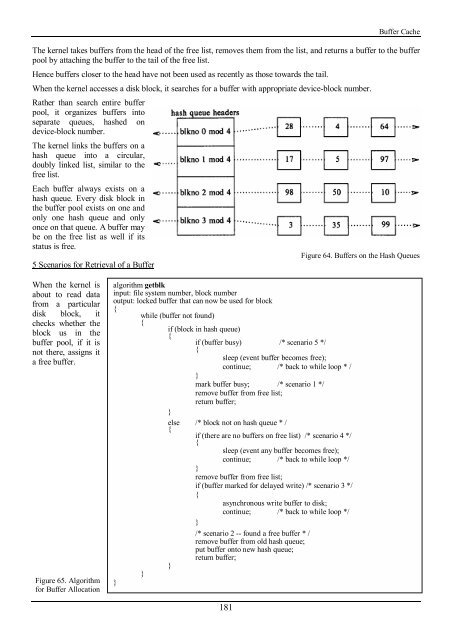You also want an ePaper? Increase the reach of your titles
YUMPU automatically turns print PDFs into web optimized ePapers that Google loves.
Buffer Cache<br />
The kernel takes buffers from <strong>the</strong> head of <strong>the</strong> free list, removes <strong>the</strong>m from <strong>the</strong> list, and returns a buffer to <strong>the</strong> buffer<br />
pool by attaching <strong>the</strong> buffer to <strong>the</strong> tail of <strong>the</strong> free list.<br />
Hence buffers closer to <strong>the</strong> head have not been used as recently as those towards <strong>the</strong> tail.<br />
When <strong>the</strong> kernel accesses a disk block, it searches for a buffer <strong>with</strong> appropriate device-block number.<br />
Ra<strong>the</strong>r than search entire buffer<br />
pool, it organizes buffers into<br />
separate queues, hashed on<br />
device-block number.<br />
The kernel links <strong>the</strong> buffers on a<br />
hash queue into a circular,<br />
doubly linked list, similar to <strong>the</strong><br />
free list.<br />
Each buffer always exists on a<br />
hash queue. Every disk block in<br />
<strong>the</strong> buffer pool exists on one and<br />
only one hash queue and only<br />
once on that queue. A buffer may<br />
be on <strong>the</strong> free list as well if its<br />
status is free.<br />
5 Scenarios for Retrieval of a Buffer<br />
Figure 64. Buffers on <strong>the</strong> Hash Queues<br />
When <strong>the</strong> kernel is<br />
about to read data<br />
from a particular<br />
disk block, it<br />
checks whe<strong>the</strong>r <strong>the</strong><br />
block us in <strong>the</strong><br />
buffer pool, if it is<br />
not <strong>the</strong>re, assigns it<br />
a free buffer.<br />
Figure 65. Algorithm<br />
for Buffer Allocation<br />
algorithm getblk<br />
input: file system number, block number<br />
output: locked buffer that can now be used for block<br />
{<br />
while (buffer not found)<br />
{<br />
if (block in hash queue)<br />
{<br />
if (buffer busy) /* scenario 5 */<br />
{<br />
sleep (event buffer becomes free);<br />
continue; /* back to while loop * /<br />
}<br />
mark buffer busy; /* scenario 1 */<br />
remove buffer from free list;<br />
return buffer;<br />
}<br />
else /* block not on hash queue * /<br />
{<br />
if (<strong>the</strong>re are no buffers on free list) /* scenario 4 */<br />
{<br />
sleep (event any buffer becomes free);<br />
continue; /* back to while loop */<br />
}<br />
remove buffer from free list;<br />
if (buffer marked for delayed write) /* scenario 3 */<br />
{<br />
asynchronous write buffer to disk;<br />
continue; /* back to while loop */<br />
}<br />
/* scenario 2 -- found a free buffer * /<br />
remove buffer from old hash queue;<br />
put buffer onto new hash queue;<br />
return buffer;<br />
}<br />
}<br />
}<br />
181
















